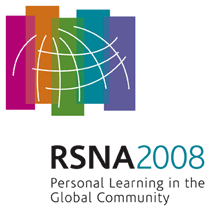
Abstract Archives of the RSNA, 2008
LL-IN2092-R04
Three Critical Dimensions of RIS/PACS Implementation in a Large Healthcare Provider
Scientific Posters
Presented on December 4, 2008
Presented as part of LL-IN-R: Informatics
Moshe Ayal PhD, Presenter: Nothing to Disclose
Abraham Seidmann PhD, Abstract Co-Author: Speaker, Bayer AG
Research funded, Bayer AG
We explore the critical RIS/PACS implementation issues in a large hospital and construct an econometric model of benefits. Dimensions studies are: tangible benefits, e.g., turnaround time reduction, cost savings, and improved billing; intangible benefits including staff, and customer satisfaction; and new features.
Using multiple linear regression models we studied the level of technology usage by the referring MDs. Ex Ante, we looked at 150,000 studies in terms of overall charges and at 600 studies in terms of reports turn around times and process bottlenecks. This effort was repeated following the RIS/PACS implementation, this time analyzing more than 180,000 studies in terms of reports' turn around times (TAT), process bottlenecks, and overall charge capture. We conducted and analysed referring MDs ex ante (150 responses) and ex post (70 responses) satisfaction survey along with an ex ante (50 responses) and ex post (68 responses) staff satisfaction survey.
Satisfaction level of both customers and staff from the new process has more than doubled, as TAT has been reduced significantly by 80% following a classical learning curve pattern. Statistically significant increased satisfaction after RIS/PACS Implementation: specifically: Final radiology report satisfaction increased in 2.133 (P<.001) using Likert scale points on a 1-7 scale (median is up from 3 to 5.5), and Images/films availability 1.524 (P<.001) scale points (median is up from 3.5 to 6). In addition, advanced technology usage by referring physicians is proved to be a significant factor in predicting total satisfaction from the service, an increase of 0.556 (P<.01) scale points in an R2=72% model. Staff satisfaction is up from 4 to 6 (medians, P<.001). Procedure volume went up from 10,000 to 12,000 per month over a two years period with no staff increment. Charge capture was increased by close to 40% over a two years period.
We have objectively measured the impact of RIS/PACS in situ, looking at tangible and intangible benefits. The study helps identify the potential for fuller utilization of next generation RIS/PACS functionality, directing users to a significant return on investment
The study leads to optimized utilization of RIS/PACS functionality with a significant return on investment for providers, while delivering improved patient care and acceptance by referring physicians.
Ayal, M,
Seidmann, A,
Three Critical Dimensions of RIS/PACS Implementation in a Large Healthcare Provider. Radiological Society of North America 2008 Scientific Assembly and Annual Meeting, February 18 - February 20, 2008 ,Chicago IL.
http://archive.rsna.org/2008/6008535.html

